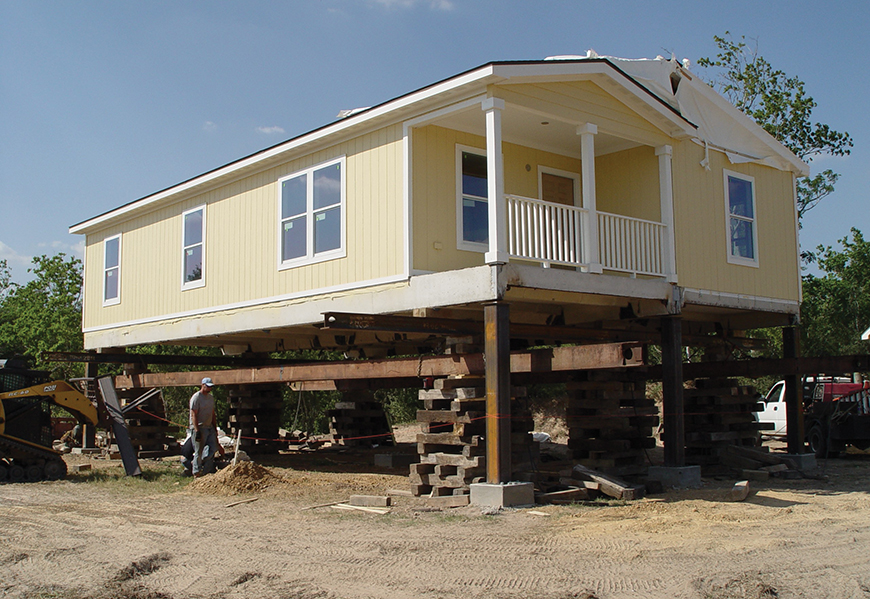
Ahead of the Storm

The Takeaway Population growth has pushed housing development into more flood-prone areas of the state. New products and methods can help residents in these areas protect their homes against floodwaters and minimize damage caused by hurricanes and other severe weather events. |
Weather-related flooding of homes in Texas is nothing new. Hurricanes and other heavy rainfall events have been damaging residential properties for decades. However, Hurricane Harvey’s unprecedented 50-plus inches of rain heightened many homeowners’ concerns about their vulnerability to flooding.
In addition, strong population growth has led to more housing in low-lying and coastal areas of the state. As a result, home flooding has become more commonplace in Texas.
To reduce the chances of flood-related damage, potential new-home buyers can familiarize themselves with effective flood-resistant techniques and products before construction begins when implementation cost is lowest. Existing homeowners can benefit from discovering what methods and products are most effective in protecting their current residence against flooding.
Changes in residential construction materials and techniques occur slowly. Builders have little incentive to use advanced materials or methods to reduce flood damage if they feel no pressure from homebuyers or the government to do so. Adoption will occur much faster if it is demand-driven by informed consumers.
Governor’s Hard Look at Disaster Preparation
Eye of the Storm, a report by the Governor’s Commission to Rebuild Texas, was published in November 2018. The report recommended ways Texas can be better prepared for disasters.
A key strategy to avoid flooding involves establishing statewide standards or best practices to elevate structures above the base flood elevation (BFE) in flood-prone areas. Currently, Texas has no statewide standards.
BFE is defined as the elevation shown on the Flood Insurance Rate Maps for floodzones A and V inside the 100-year floodzone, an area with a 1 percent chance of a flood occurrence in any given year. The 100-year flood patterns help determine the National Flood Insurance Program (NFIP) rates for homeowners purchasing flood insurance. Zones A and V are in a Special Flood Hazard Area (SFHA). Homes with a federally backed mortgage that are in an SFHA must purchase flood insurance.
If the Federal Emergency Management Agency (FEMA) provides a community with the flood hazard information that floodplain management regulations are based on, the community can adopt its own “model" floodplain management ordinance that best fits its particular flood risks. The ordinance must meet or exceed minimum NFIP standards. At that point, the community becomes responsible for floodplain management inside its corporate limits.
Texas has no statewide model or best-practice ordinance. However, many communities have concluded that homes elevated up to the BFE are not sufficiently protected from flooding. The BFE does not account for the impacts of future development, increasing rainfall, subsidence, or rising sea levels. The report states that flooding above BFE is already fairly common in Texas.
Additional elevation is usually expressed as “freeboard," the number of feet the first inhabited floor of a building is above the BFE. A freeboard requirement is meant to provide an extra margin of protection that accounts for waves, debris, changing future weather conditions, new development, and a lack of accurate data. Individual communities can adopt their own freeboard requirements.
A national study by two professors, Wes Highfield and Sam Brody of Texas A&M University at Galveston, found freeboard requirements to be the most effective of all mitigation strategies in terms of avoiding flood damage to residential structures. Elevating structures above the BFE can significantly lower homeowners’ federal flood insurance rates.
Ways Homeowners Can Address Potential Flooding
In another study published in 2017, Brody, Highfield, and Yoonjeong Lee (also of Texas A&M University at Galveston) surveyed coastal residents in parts of Texas and Florida. Results showed household actions to reduce flooding included a variety of activities and costs. Three primary categories of residential flood mitigation techniques were defined based on the expense, time, and amount of effort involved.
The least-expensive flood mitigation involves simply gathering and exchanging helpful information about the purchase of flood insurance, contacting different agencies for flood-hazard information, and attending meetings to discuss local flood hazards.
The next level of mitigation entails “wet floodproofing" a home. With wet floodproofing, permanent or contingent measures are put in place to resist, not prevent, flood damage. Uninhabited portions of a home, such as crawlspaces or first floors used for parking or storage, are constructed or modified to allow floodwaters to enter and exit. Flood-resistant materials are used below the BFE along with vents or breakaway walls. In addition, measures are taken to protect utility systems.
The highest level of mitigation involves the most time and greatest expense. Major changes are required, such as elevating the entire house or adding a new floor, erecting an earthen barrier or berm around the home, or “dry floodproofing" exterior walls and doors.
Dry floodproofing involves making a home watertight below the level that needs flood protection. This requires sealing the walls with some type of waterproof coating or impermeable membrane. Floodproof doors and windows are sealed as well.
FEMA states that “dry floodproofing may not be used to bring a substantially damaged or substantially improved residential structure into compliance with the community’s floodplain management ordinance or law." However, new innovations and construction methods have been used to test the viability of dry floodproofing a home.
Brody, Highfield, and Lee contended that some homeowners who were informed and aware of their flood risks may have already decided to locate outside of flood zones or at higher elevations. The study concluded survey respondents as a whole were typically not aware of the actual flood risk to their properties.
Educated Consumers, Informed Decisions
An extensive investigation of all the methods and technologies currently available to protect against flooding is impractical. Three are discussed in the sidebars “Buoyant Solution to Home Flooding," “Raising the Standard in Modular Home Flood Prevention," and “Weathering the Storm Through Innovative Thinking."
Unfortunately, the frequency, timing, and severity of future flooding at a specific location cannot be predicted. Hurricane Harvey proved that, under the right conditions, areas thought to be safe from flooding may not be. As a result, homeowners should ask questions and carefully consider their options before spending money on flood-protection upgrades.
Each homeowner has a unique financial situation and level of risk aversion. If funds are available, how much should be spent on flood protection? Will the potential benefit exceed the cost?
A traditional “payback period" calculation may not be appropriate when there is no way to know if flood-protection measures will ever be needed. Will money spent on flood protection add to the home’s market value? Does it matter if no value is added?
Would it be better and more cost effective to just relocate to a higher elevation? This option may not be available to low-income families living in vulnerable areas.
At the basic level, becoming better educated on flood protection merely requires an expenditure of time and energy, not money. When money is required, a significant degree of thought and self-evaluation is essential before making any final decisions.



For More Information
Eye of the Storm (169-page Governor’s Report)
National Flood Insurance Program (NFIP) Glossary and Basic Explanations
Flood Insurance Basics
Flood Insurance Rate Maps (FIRMs)
Wet Floodproofing Discussions (FEMA)
Dry Floodproofing Discussions (FEMA)
Reducing Flood Risk to Residential Buildings That Cannot Be Elevated (FEMA)
The SURE House
FloodFrame Technology
____________________
Dr. Hunt ([email protected]) is a research economist with the Real Estate Center at Texas A&M University.
You might also like

Publications
Receive our economic and housing reports and newsletters for free.






